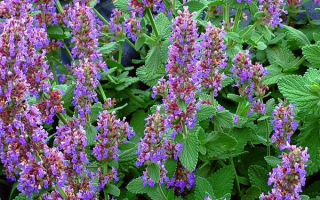Content
- 1 What does melissa look like and where does it grow?
- 2 The chemical composition of lemon balm
- 3 Useful and medicinal properties of lemon balm
- 4 Can lemon balm for pregnant and lactating women
- 5 At what age can lemon balm be given to children
- 6 Traditional recipes with lemon balm for the treatment of diseases
- 7 Lemon balm pillow
- 8 Lemon balm essential oil: benefits and uses
- 9 The benefits of lemon balm tea
- 10 Can lemon balm for gastritis
- 11 Is lemon balm good for diabetes
- 12 The use of lemon balm in cosmetology
- 13 Is lemon balm used in cooking
- 14 Potential harm to lemon balm and contraindications
- 15 Which is healthier: lemon balm or mint
- 16 When to collect and how to dry lemon balm at home
- 17 Conclusion
- 18 Reviews
The benefits and harms of lemon balm have been studied quite well, since this plant has been cultivated by mankind for more than one thousand years. The medicinal properties of the drink from this plant have many beneficial effects and are widely used in folk medicine.
What does melissa look like and where does it grow?
Melissa is a herbaceous shrub up to 30 cm to 1.2 m in height with a branching root system. The stem of the plant has a specific four-sided shape; it is covered with pubescence of short hairs. The leaves are ovoid or rhombic in shape, they are also downy. The flowers of the plant are collected in rings of about a dozen pieces, each have 4 leaves of white or purple.

The homeland of the plant is considered the southern coast of the Mediterranean Sea, but the growing area is quite wide. It can be found throughout Europe, North America, the Caucasus and Central Asia.
The chemical composition of lemon balm
The oil contained in the plant is responsible for the scent of lemon balm and explains most of its beneficial properties. Lemon balm contains on average 0.2% oil. This concentration depends on the composition of the soil, weather and climatic conditions. In very rare cases, it reaches 0.8%. If we consider the plant in its individual parts, then the maximum concentration falls on the leaves (up to 0.4%).
The essential oil contains the following monoterpenes:
- citral (about 2/3 of the composition);
- citronellal;
- citronellol;
- geraniol.
The first two provide the characteristic lemon scent of lemon balm.
Another group of chemicals, phenylpropanoids, is represented by the following acids:
- rosemary;
- coffee shop;
- chlorogenic.
The flavonoids that make up the oil include:
- apigenin;
- cinaroside;
- rhamnocitrin.
The following components belong to the group of carbolic acids:
- salicylic;
- vanilla;
- lilac;
- coumarins;
- tannins.
The plant's vitamin composition is scarce (there are few representatives of group B, provitamin A and vitamin C), but the mineral composition is quite diverse and includes almost all trace elements from potassium to selenium.
It is difficult to talk about the quantitative composition and concentration of certain components. Like the composition of the oil, these characteristics depend on many external factors. In different growing conditions, plants can sometimes differ by an order of magnitude.
Useful and medicinal properties of lemon balm
The benefits of lemon balm for the human body primarily lie in the fact that it is a powerful sedative.This is one of the simple and affordable psycholeptics, that is, drugs that reduce emotional stress. Leaf tea is useful for various types of neuroses, depression, excessive excitability and insomnia.
The substances included in the plant allow the body to better resist diseases of the cardiovascular system. First of all, tachycardia and hypertension.
The anti-inflammatory effect of the plant is used in the treatment of diseases associated with inflammation of the respiratory system. External use is recommended for various skin diseases - they treat ulcers, eczema and dermatitis. In addition, lemon balm decoction is used in the prevention and treatment of gastrointestinal diseases.
Flavonoids, which are part of the essential oil, are powerful antioxidants and allow the body to fight the accumulation of free radicals, reducing the risk of cancer.

The benefits of homemade tea with mint and lemon balm are even more pronounced, since these plants, being approximately the same in effect, slightly enhance each other's properties.
Why is lemon balm useful for women
The effect of lemon balm on a woman's body has a number of specific features. This plant is also called "female grass". Tea made from it is recommended for menstrual pain. The properties of lemon balm with menopause will also be useful. The sedative effect of using the plant helps to cope with the listed female ailments.
Lemon balm is also recommended for breastfeeding, since its medicinal properties increase the volume of breast milk produced.
The use of various decoctions from the greens of the plant is to improve the condition of the skin and protect it from all kinds of rashes and infections. Melissa for the health of women is used not only as a therapeutic, but also as a cosmetic agent.
The benefits of lemon balm for men
The plant helps the male body by helping to maintain muscle tone and helps with erectile dysfunction. After all, the cause of this trouble in most cases is neurosis. Tea from the leaves of the plant helps to deal with them.
The phytoandrogens contained in the stems of lemon balm are natural analogues of male sex hormones. This allows it to be used for patients with hormonal disorders without affecting potency.
Can lemon balm for pregnant and lactating women
The benefits of lemon balm tea during pregnancy are beyond doubt. The drink is not contraindicated in this situation, but is recommended by specialists. Melissa during early pregnancy helps a woman to fight puffiness and toxicosis. Its beneficial effect suppresses the gag reflex and reduces the feeling of nausea.

Melissa for nursing mothers is a useful plant, as it not only increases lactation, but also soothes the mother and baby. In addition, many trace elements and vitamins of group B enter the child's body. Thanks to the use of lemon balm, the child's immunity is strengthened and the digestive tract is stabilized.
At what age can lemon balm be given to children
There is no consensus about the age at which children can consume drinks from the plant. From the point of view of classical medicine, lemon balm can be used from six months, however, a wide range of its effects can adversely affect the health of the baby. Therefore, many experts advise not to use it before the child reaches the age of three.

In any case, the use of teas and decoctions from the plant should be carried out after consulting a pediatrician or doctor.
Traditional recipes with lemon balm for the treatment of diseases
The benefits of a plant like lemon balm can be manifested in various situations, and it can be used in many forms.Usually, plant-based folk remedies are used in the form of all kinds of decoctions and tinctures.
Lemon balm infusion
This remedy is used in the treatment of diseases of the digestive system. To prepare it you will need:
- plant leaves (dry - 5 g or fresh - 15-20 g);
- half a liter of water.

Chop the leaves and add hot water. After which the container should be closed and infused for about an hour. Then the resulting drink is filtered and consumed in 100-150 ml half an hour before meals. Every day the infusion is prepared anew. Helps with stomach pains (used for ulcers and gastritis).
Lemon balm decoction
To make a decoction of dried herbs you will need:
- dry lemon balm - 1 tbsp. l .;
- boiling water - 250 ml.
Preparation: the herb is poured with boiling water without grinding and sent to a water bath for 3 minutes. After which the resulting mixture is infused for about 2 hours. This broth is used for insomnia: the resulting liquid is divided into 2 parts and taken in the evening and immediately before bedtime.
A decoction of fresh herbs is useful for diseases of the gastrointestinal tract, colds and neuroses.
The recipe for its preparation:
- 10 g of greens are finely chopped and placed in 300 ml of water;
- the mixture is boiled for 10 minutes;
- then the broth is filtered and cooled.
You need to take it 5-10 ml three times a day with meals. The broth is stored in the refrigerator for no more than 1 week.
Melissa tincture
Depending on the amount of plant leaves used in preparation, the tincture can be used to treat colds or gastritis and ulcers.

A tincture recipe for colds includes the following ingredients:
- leaves (dry - 10 g, fresh - 50 g);
- vodka - 150 ml;
- water - 100 ml.
Fresh leaves need to be dried a little, but not until the moisture has completely evaporated. After that, the raw materials are crushed and placed in a container, which is filled with vodka, then water is added. The mixture is tightly closed with a lid and placed in a dark place for a month.
In case of a cold or to improve immunity, you need to use the tincture in the amount of 25 drops three times a day, combining with food intake. For diseases of the stomach, the tincture is used in the same doses, the general course of treatment is four weeks. Alcohol tincture also helps with skin diseases. To do this, it needs to be applied 2-3 drops to problem areas.
Lemon balm baths and compresses
This useful remedy helps with bruises, rashes and joint diseases, in particular arthritis. To prepare a solution for a compress, you will need 50 g of dried herb. It is poured with 2 liters of boiling water, after which it is infused for 60 minutes.
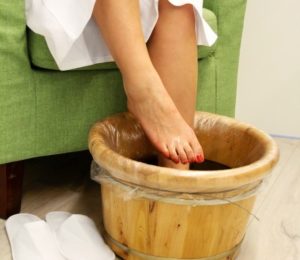
After the product has cooled, you can use it as a bath for the hands or feet. Application to other areas of the skin is carried out using cotton-gauze compresses.
Melissa bath
A herbal bath is prepared as follows: 50 g of plant greens are taken and filled with a liter of water. Then the mixture is boiled for 10 minutes and filtered into a bath of water.
The beneficial properties of this procedure are to relieve fatigue or stress and to activate blood circulation.
Lemon balm pillow
The aroma of the plant not only helps relieve stress, but also improves metabolism. The anticonvulsant effect of this agent has also been noted.

Usually small pillows are made, measuring 20 by 20 cm, of linen or cotton. They are stuffed with dried leaves and plant stems. In this case, it is advisable to use the grass grown in the last season in order to preserve its properties as long as possible. The service life of such a pillow is about two years, after which it should be refilled.
Lemon balm essential oil: benefits and uses
The resulting essential oil has all the properties of a plant and is used both in medicine and in cosmetology. It is believed that this drug is one of the best against colds and ARVI among all essential oils.

One of the important properties of the oil is its enhanced analgesic effect for headaches and menstrual pains.In addition, it reduces blood pressure and normalizes the functioning of the cardiovascular system.
The benefits of lemon balm tea
Despite the variety of preparations obtained from the plant, it is tea that is the most common way of using lemon balm. The useful properties of the broth are as follows:
- maintains the tone of the body,
- improves heart activity,
- stimulates appetite.
Also, the drink helps with fatigue and colds, has a relaxing effect.
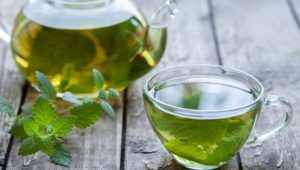
The benefits of tea in combination with mint and lemon balm are especially well manifested, since the complex effect of these herbs is slightly higher than each separately.
How to brew lemon balm tea
The recipe for its preparation is quite simple: you need to pour a teaspoon of finely chopped plant leaves with 1.5 cups of boiling water and let it brew for half an hour. The drink is consumed without sugar.
Melissa tea recipes
In addition to tea from lemon balm leaves, a drink from its flowers is used. Its effect is less pronounced and is often used as a thirst quencher. The recipe is similar to the "classic" one, only flowers are taken not leaves.
Green tea with lemon balm is used to lose weight or strengthen the immune system. It is done as follows:
- mix 100 g of green tea with 2 tsp. lemon balm, mint, valerian and motherwort;
- 2 tsp the resulting tea-herbal mix is filled with 200 g of boiling water and infused for 20-30 minutes.
The tool is used up to four times a day.
To improve digestion, lemon balm tea is used for the stomach. The recipe is as follows: 30-50 g of dried herbs are poured into 1 liter of boiling water and insisted for half an hour. Consume 200 g 3 times a day before meals.
The beneficial properties of lemon balm tea for pancreatitis during an exacerbation of the disease help to cope with unpleasant sensations. The preparation of the drink is carried out by mixing the following components:
- 2 tbsp. l. lemon balm and dandelion;
- 1.5 sl. l. chamomile;
- 5 tbsp. l. oats.
The resulting mixture is divided into 2 parts, and one of them is poured with 1 liter of boiling water. It is infused for half an hour and taken in 100 ml before meals.
Can lemon balm for gastritis
Melissa can be used for gastritis in the form of a decoction, infusion or alcohol tincture. Usually it is applied 10-15 ml of the product in water or 20-30 drops in alcohol 2-3 times a day with meals.
Is lemon balm good for diabetes
According to doctors, people with diabetes can take drinks from the plant, as they speed up the metabolism and help in the removal of free radicals from the body. In addition, its use improves the work of the digestive tract and circulatory system. There are no restrictions for diabetics.
The use of lemon balm in cosmetology
The beneficial effect of the components that make up the plant promotes its use in cosmetology. Because of their beneficial properties, decoctions and infusions are used both as independent skin and hair care products, and as part of various creams or masks.
Face masks
An anti-wrinkle mask will require the following ingredients:
- 20 ml of water herb infusion;
- 10 g kelp;
- 15 drops of rice oil.
Laminaria are poured with infusion for 45-60 minutes, then oil is added to the mixture. The mask is applied to the steamed skin of the face and washed off after half an hour with water.
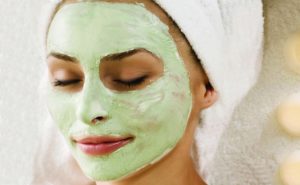
Acne mask:
- 10 ml of plant juice;
- 20 g of white clay;
- 5 drops of ginger oil.
All ingredients are mixed to the consistency of sour cream and applied to the skin of the face cleansed with lotion. The mask is washed off after 15 minutes
Melissa for hair beauty
The essential oil of the plant is mainly used. 10-20 ml of oil is heated in a water bath and rubbed into the hair. Then you need to put a plastic cap on them and stand for about half an hour. The mask is washed off with a shampoo with conditioner.
Is lemon balm used in cooking
The plant is used as a spice. Its leaves, which have a lemon flavor, are mainly used.Fresh they are added to salads, soups and vegetable side dishes. The dried leaves are used in meat and fish dishes. Melissa is used in sauces and pickles.
Potential harm to lemon balm and contraindications
The health benefits and harms of lemon balm have been well studied, we can say that this plant is devoid of any contraindications, except for the following cases:
- individual intolerance;
- low blood pressure.
Which is healthier: lemon balm or mint
Pure medicinal and culinary properties in both plants are very similar. A slight difference appears when exposed to oils from their composition. If lemon balm retains a sedative effect, then mint has the opposite effect.
Mint has more contraindications. These include varicose veins, heartburn, and drowsiness. Serious restrictions in mint and when used by pregnant and lactating women, as well as children. The benefits of mint for the male body are also considered questionable.
The nutritional value of plants also differs: mint is about 50% more caloric than lemon balm. The vitamin composition is approximately the same, however, ascorbic acid and B vitamins are more in mint (by 50-100%).
When to collect and how to dry lemon balm at home
Lemon balm is harvested during its flowering, practically throughout the summer. This uses the leaves and flowers of the plant. You can take 2-3 crops per season. Shoots are cut after the dew has completely disappeared from the plant.
Drying of the plant is done in the shade. Most often this is done in well-ventilated places: in attics, summer gazebos, under awnings. You can dry it in the oven (at a temperature of about + 35 ° C), but this will significantly impair the beneficial properties of the plant.
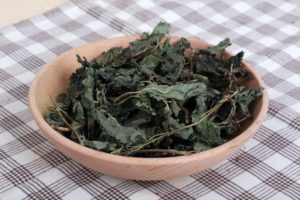
Dried herbs are stored in a sealed glass container without access to sunlight at a temperature not exceeding + 20 ° C and a relative humidity of not more than 60%.
Conclusion
The benefits and harms of lemon balm have long been known; the plant is widely used in medicine, cooking and cosmetology. By its properties, it is softer than mint and has fewer contraindications. The versatility of the plant allows it to be used in a wide variety of situations without any serious consequences.

